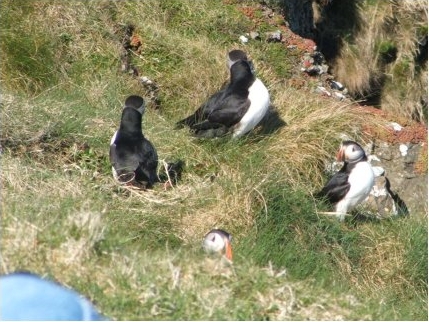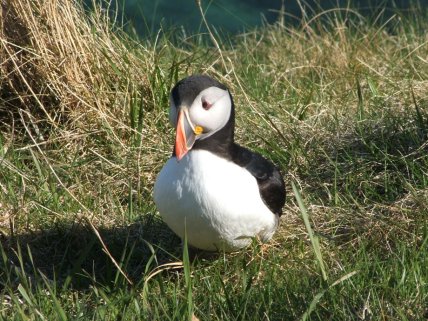« The light shines in the darkness..... | Main | Guest Post »
May 02, 2006
Puffins and geology
The island of Staffa, North of Iona and West of the Isle of Mull, is a geological gem. The island is composed of layers of volcanic ash and huge basalt columns. These columns formed millions of years ago when hot flowing basalt lava flowed over a layer of ash (several hundred feet thick in places) and then was suddenly cooled by immersion. This causes the basalt to form into hexagonal, sexagonal and even octagonal "pillars".
An islet at the Southern coast of Staffa built of *gonal-shaped basalt pillars
Those on Staffa are matched by the Giants Causeway in Antrim, 70 miles away on the coast of Ireland. Legend links the two places as Staffa is the site of Finghal's Cave and in Irish folk legends, the islands of Western Scotland are boulders thrown by the Irish giant Finn M'Couhl in a battle with an enemy on the Scottish side.
The spectacular basalt pillars which form the island of Staffa, with Finghal's cave opening to the right.
We were fortunate to have a flat calm sea and almost no breeze for our trip to Staffa from Fionnphort, as it allowed us to enjoy the spectular views of the variety of sea birds, the clear seas and the surrounding islands - the Isles of Treshnish. Climbing the cliffs and certainly clambering along the ledge into Finghal's Cave is not recommended in rough weather since the landing stage at the island is approached between a huge basalt pillar pile and two submerged ledges. The sea breaks through the gap between Staffa and the outlying basalt islet with some force according to our skipper and I can well believe him.


Puffins - straight out of Enid Blyton's famous "The Sea of Adventure"
The climb up the cliff face is well worth the effort as is the trek to the other end of the island. The Puffins had arrived only a few weeks earlier - they spend the winter in mid-Atlantic - and rather like having people visit as this drives away the guillemots, Herring Gulls and other birds that rob them and their underground nests. As the pictures show, they waddled quite close to us and the other members of the party. Funny little fellows, there is apparently little distinction between male and female that humans can spot - so presumably the Puffins know and can tell easily enough! They make a strange groaning and grumbling noise as they congregate and this goes on all the time. In flight they are quite graceful, with wings designed for skimming and swimming. They have been recorded diving to almost 60 metres, but more usually swim down to between 20 and 30 meters to catch sand eels.
Departing Staffa after an hour on the island, our skipper announced that, as several elderly members of the party had not seen the Puffins close too, nor been able to get to Finghal's Cave, he would make a small detour. He did, we got a close view of a raft of Puffins swimming and diving and then, in a feat of seamanship that was thoroughly professional and displayed his skill, took the 70 foot launch into the mouth of Finghal's Cave, stopped engines and drifted gently part way into the interior.
A thoroughly memorable and truly worthwhile trip!
Posted by The Gray Monk at May 2, 2006 07:30 AM
Trackback Pings
TrackBack URL for this entry:
http://mt3.mu.nu/mt/mt-tb.cgi/4234
Listed below are links to weblogs that reference Puffins and geology:
» Geology from Geology
This area is open to students, university instructorsGeneral information, newsletter, state geologic map.The museums website has photos, news, ho... [Read More]
Tracked on May 15, 2006 07:50 AM